How to Train Your Dog to Ignore Other Dogs (Tips & Tricks)
- from Anja Boecker
- Updated: 6 June, 2023
For many dogs and their owners, encounters with other dogs can be quite stressful. To avoid uncomfortable situations, it's important to learn how to train your dog to ignore other dogs. After all, these are the kinds of encounters you will encounter while walking your pet.

Therefore, You Should Train Your Dog to Ignore Other Dogs
For a variety of reasons, many dogs react to their peers in undesirable ways. This causes stress for both people and animals. In fact, a pet can be on the receiving end of an aggressive attitude!
However, a dog may still be barked at despite remaining completely relaxed. Unfortunately, unpleasant encounters are unavoidable, but you can make them less likely. You just need to learn how to train your dog to ignore other dogs.
Dog encounters can be challenging for many dog owners, especially if the dog is anxious, insecure, or overly excited. Here are some reasons why it pays to train for dog encounters:
- Socialization: Dogs are naturally social animals, and it is important for their overall development and well-being that they learn to interact appropriately with other dogs.
- Behavioral Control: Dog encounter training teaches your dog to react in a calm and controlled manner instead of becoming fearful or aggressive. This can help prevent potential conflicts.
- Trust and Commitment: Training strengthens the bond between you and your dog. Your dog learns to trust you and respond to your cues, making your life together easier.
- Safety: A well-trained dog is less dangerous to other dogs and people.
- Social Responsibility: As a dog owner, you must ensure that your dog is socially acceptable and behaves appropriately in public.
- Joy of Walking: A dog that gets along well with other dogs will make walking a much more enjoyable experience for both of you.
It is important to remember that dog training takes time and patience, but the rewards are worth it. It is also important to keep the training positive and rewarding to avoid stress and anxiety.
Reasons for Stressful Dog Encounters
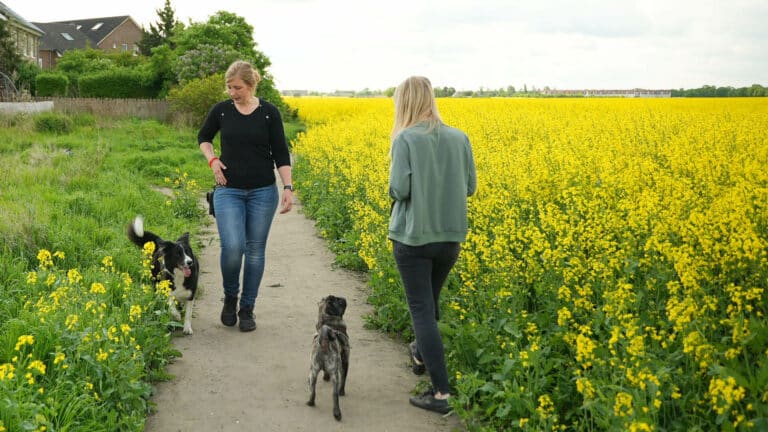
There are several factors that can make a dog encounter stressful. Here are some of them:
- Unbalanced energy: When one dog meets another that has a very different energy level (for example, a very active dog meets a very quiet dog), it can cause stress.
- Poor Socialization: Dogs that are not well socialized, meaning they have not learned how to behave around other dogs, can feel insecure and stressed.
- Personal experience and temperament: A dog that has had bad experiences with other dogs in the past may be stressed in future encounters. Likewise, dogs with fearful or insecure temperaments may be more stressed than others.
- Leash aggression: Some dogs feel restricted on a leash and may react more aggressively to other dogs. This so-called leash aggression can lead to stressful encounters.
- Health Problems: Dogs in pain or with health problems may become stressed when approached or touched by other dogs.
- Inappropriate playing styles: Not all dogs play the same. Some are very physical, while others prefer to chase or follow. Mixing dogs with very different play styles can lead to misunderstandings and stress.
- Unclear communication: Dogs communicate with each other through body language. If one dog misinterprets or ignores the other's signals, it can lead to stress and conflict.
It is important to monitor the dog's behavior and well-being during encounters with other dogs and to seek professional help if necessary. Each dog is an individual and what is stressful for one dog may not be stressful for another. Therefore, an individual approach is often the best way to go.
There are many reasons why many encounters are stressful. When walking, be sure to only let your dog see other dogs when he is truly relaxed.
If not, socialization with another dog may become heated. If your pet is feeling anxious, it may be a good idea to take a long walk away from other dogs.
Many owners believe that they must let their pets play with their peers. This is half true: dogs don't necessarily need to socialize with their peers to develop proper social behavior.
In the wild, dogs do not change their companions all the time, but stick with the ones they know. Therefore, it is not necessary to leave your dog with every dog you meet.
If both dogs are clearly interested in each other, you can let them sniff each other. Most of the time, however, the interest will fade quickly and they'll casually separate. After all, they feel more secure in their own packs.
Dogs that live with people see them as their pack. As long as there is peace in the family, the dog is content and feels safe. A dog that feels safe reacts much more calmly than an anxious animal.
In addition, dogs are most comfortable in the environment they know best. It's not uncommon for pets to ignore other dogs: they just want to mind their own business. This is perfectly okay.
In any case, there's no reason to force social interaction. If you don't take into account your pet's personality, there is no way to learn how to train your dog to ignore other dogs.
There are also dogs that are very social and dogs that are very shy. Over time, you'll find that you'll often cross paths with the same pets.
If you know for sure that meetings with a particular dog will be stressful, it is better to move on quickly. It is rather rare for the dog's behavior to change. Pay attention to your dog's body language. If he raises his head, bristles, or wags his tail, these are clear warning signs.
Your dog is physically showing fear. It's better to withdraw than to force a stressful encounter. In addition, you should watch not only your pet's reactions, but also those of its owners. If they are loud or nervous, it is a bad sign: such behavior is transmitted to their companions.
My Dog Barks at Other Dogs - 5 Reasons Why
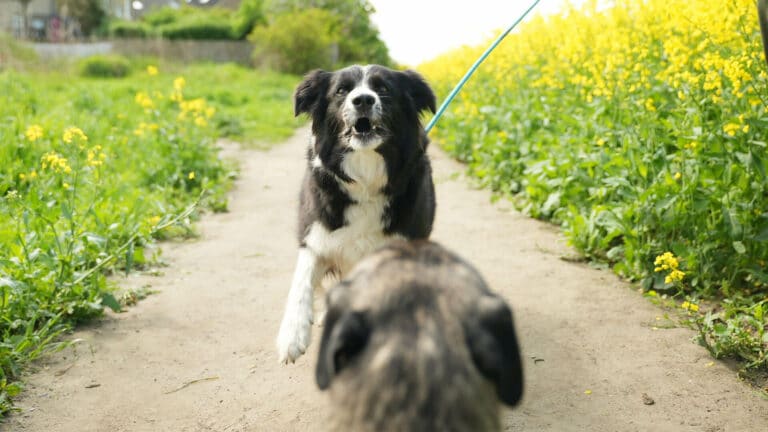
Dogs may bark during encounters with other dogs for a variety of reasons.
Aggression is not always the cause of loud barking. Excitement can also be the cause of barking.
Sometimes dogs have had bad experiences and become defensive. It is important to identify the reason for the barking. Excited dogs are more likely to bark during a walk than dogs that are relaxed when leaving the house.
For this reason, you should refrain from wild games in the house that excite the dog. Otherwise, the dog will have to reduce this excitement during the walk.
It's important to look at your dog's specific behavior and the context of the situation to determine the cause. Here are 5 possible causes:
Fear or Uncertainty: Dogs may bark at other dogs when they feel unsafe or frightened. This can be a defensive behavior to keep the other animal at a distance.
Excitement: Some dogs bark out of pure excitement when they see other dogs. They may want to play and this is their way of showing their excitement.
Territorial behavior: Some dogs can be very territorial and will bark at other dogs they see as intruding on their territory.
Poor Socialization: If a dog is not well socialized, it may not know how to behave around other dogs. In this case, barking can be a form of unsafe communication.
Frustration: Dogs that are on a leash and not allowed to go to other dogs may feel frustrated and express it by barking (this is sometimes called leash frustration).
To improve this behavior, it may be helpful to consult a professional dog trainer. They can teach you specific techniques and strategies to help your dog control his reactions and have more positive encounters with other dogs.
You can find more information about barking in the article How to Get a Dog to Stop Barking in 5 Steps
How to Relax Your Dog Effectively to Ignore Other Dogs
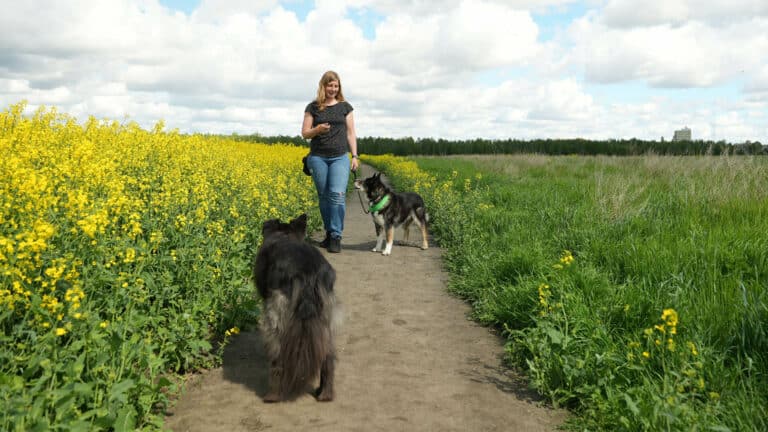
In order to know how to train your dog to ignore other dogs, you first need some preventative measures: you need a way to redirect your pet's attention.
You can do this by giving him a toy, handing him a treat, or playing with him.
So just keep your dog's attention on you. You can also just run or change direction. It's also okay to just turn around if you can't avoid the other dog because of space; the dog shouldn't have to attack or flee to get out of the situation.
You can also distract yourself by thinking and feeling positive. Dogs are very sensitive to the feelings of their owners. If your dog barks, stay as calm as possible. Barking is annoying, but it's not the worst case scenario.
Scolding and yelling will not help. Keep a cool head. Strict commands like "sit" are also useless, if the dog is excited, it will not sit. Dogs will calm down quickly.
However, don't let your dog bark uncontrollably and stand your ground. Otherwise, your dog will challenge your role as leader of the pack. At the same time, pulling on the leash won't help.
Coercion, such as an electric shock collar, is cruel to animals and therefore absolutely reprehensible. Such mistreatment leads to a breach of trust and makes your dog unhappy. Love is the foundation of any relationship.
How to Train Your Dog to Ignore Other Dogs
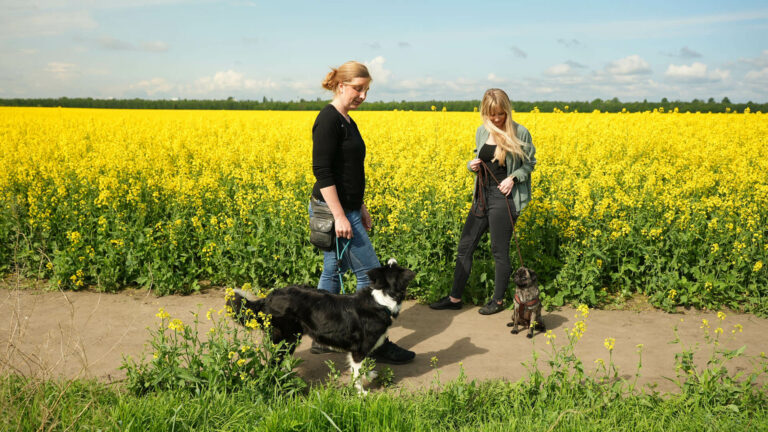
It can take time and patience to teach your dog to ignore other dogs, especially if he already exhibits the behavior of paying too much attention to other dogs. Here are some steps you can follow:
1) Positive Reinforcement:
Every time your dog ignores other dogs, reward him immediately. This can be done with praise, treats, toys - whatever your dog perceives as a reward. The reward should be immediate so that your dog associates the positive behavior with the reward.
2) Distraction:
If you see that another dog is nearby, try to get your dog's attention before he notices the other dog. This can be done with a treat, a toy, or a special command such as "look" or "eye contact.
3) Train in a Controlled Environment:
Begin training in a controlled environment where you can control encounters with other dogs. For example, you could practice with a friend and his well-socialized dog.
4) Take a Step-By-Step Approach:
Start with a large distance between your dog and the other dog, and gradually decrease the distance as your dog becomes calmer and more controlled.
5) Consequence:
Be consistent in your training and in your expectations. If you want your dog to ignore other dogs, don't allow him to sometimes run up to other dogs and play with them and then expect him to ignore them again.
6) Professional Help:
If your dog's behavior with other dogs is particularly challenging, it may be helpful to enlist the help of a professional dog trainer.
It is important to remember that each dog is an individual and what works for one dog may not work for another.
Some dogs have more difficulty ignoring other dogs, especially if they are older or have had bad experiences with other dogs. In such cases, an individualized approach may be needed, perhaps with the help of a professional.
How to Train Your Dog to Ignore Other Dogs - 2 Exercises
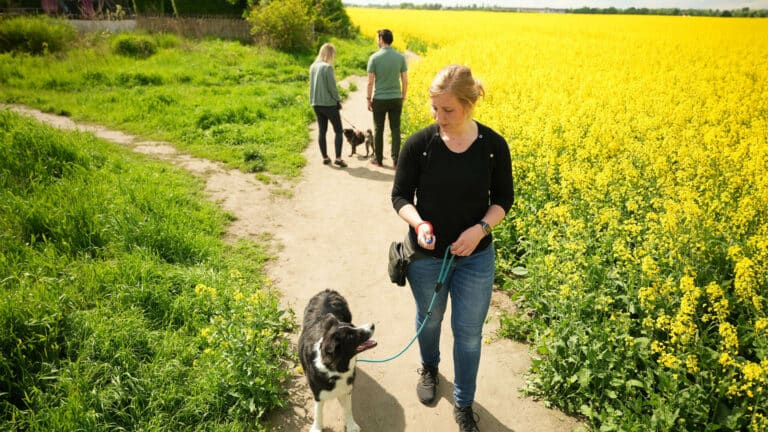
To practice meeting other dogs on a leash, there are a few steps you can follow:
Exercise 1
- Start With Distance: In the beginning, it is better for your dog to see other dogs from a distance. This will help him learn that other dogs are nothing to worry about.
- Positive Association: Use rewards such as treats or praise to signal to your dog that the encounter with other dogs is positive. Reward your dog every time he responds calmly to another dog.
- Step-By-Step Approach: Gradually decrease your distance from other dogs. Be sure to respect your dog's pace and decrease the distance only when your dog is comfortable.
- Practice With Known Dogs: If you have access to a dog that your dog already knows and likes, you can use it as a training partner. This will allow your dog to practice what he has learned in a controlled environment.
- Professional Help: If you are having trouble, a professional dog trainer can be very helpful. He or she can give you tips and techniques to make training more effective.
Exercise 2
Clicker training is an effective way to train your dog, especially when it comes to staying calm during dog encounters. Here are a few steps you can follow:
- Condition the Clicker: Before using the clicker to train your dog, you must condition your dog to use the clicker. This means that your dog will understand the clicker as a positive signal. Click the clicker and immediately give your dog a treat. Repeat this a few times until your dog knows that a click means a treat.
- Click and Reward: Begin dog meetings from a safe distance. Each time your dog sees another dog and remains calm, click the clicker and give him a treat.
- Approach: Gradually decrease the distance from other dogs while continuing to reward your dog's calm behavior with the clicker and treats.
- Increase the Distraction: Once your dog understands the concept, increase the difficulty by adding more distractions or approaching other dogs.
- Encounter: Finally, let your dog meet other dogs. If he remains calm, click and reward him. If he becomes agitated, take a few steps back and practice the calm behavior again.
It is important to be calm and patient during the training process. It may take a while for your dog to exhibit the desired behavior. But with patience and consistency, your dog will learn that calm behavior is rewarded in dog encounters.
For more exercises, visit our app and train your dog with step-by-step video instructions.
Frequently Asked Questions
The best way to train dog encounters is through distraction. Simply draw your dog's attention to you. Favorite treats and toys work best. Eye contact with your dog is also very important. If your dog is focused on you, he won't be tempted to bark at the other dog.
If you notice your dog fixating on another dog, offer an alternative. Talk to the dog in a raised voice or change direction. This will defuse the situation immediately.
Dogs don't need countless other dogs to be happy. They like to make friends with two or three dogs that they see regularly. Regular contact is more important than many fleeting encounters. Also, the pack, the human family, is more important to dogs than conspecifics. So don't feel bad if your dog doesn't play with other dogs every time you go for a walk.
Observe your dog's behavior. If he shows signs of tension, keep your distance. Dogs quickly feel pressured and react with aggression. A distance of 5 to 10 meters is good. In addition, you should walk past the dog at a brisk pace and try to maintain eye contact with your dog. Your dog should follow you with confidence.
Aggression on the leash is a problem that should be handled as calmly as possible, even if it is difficult. Of course, it's embarrassing when your dog goes berserk and yaps at other people and dogs, but you should let it go and not add to the drama by reacting. It's best to be polite to other dogs when your dog is on a leash. Yelling and punishing won't help.
The dog's attention should be on you, not on the other dog. Even if it is silly, jumping and laughing will help. As soon as your dog looks at you, he can no longer fixate on the other dog. The more playfully you can distract your dog, the better.
Conclusion
The best way to train your dog is to distract him. You can use toys and treats. Eye contact is another important tool.
Your dog should be focused on you. If your dog is generally aggressive on the leash, it is important to remain calm and keep a large distance from the unfamiliar dog.
Practice these things consistently and over time dog encounters will become much more enjoyable.
Share Now:
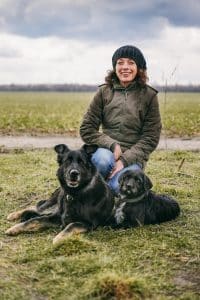
My name is Anja Boecker, and I am a certified dog trainer and behavior consultant. With these articles, I want to help you to understand your dog better and to build an inseparable bond.

